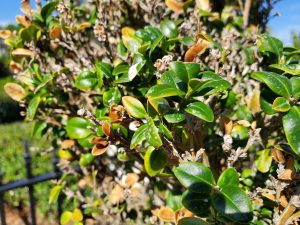After a relatively cold winter like the Florida panhandle has experienced the last couple of years, it’s always gratifying to see plants greening up in the spring. Anyone who enjoys the outdoors is likely to want to get out there and start helping things grow. That means it’s time to get the irrigation system up and running every day, right?
Probably not!
The conditions in our region can be harsh on plants. The soils are very sandy, meaning they don’t easily hold on to water or nutrients for plants to use. The weather ranges from freezing cold in the winter to sizzling hot in the summer. Rain might come down in 20-inch bursts or not at all for weeks at a time.
With all these challenges plants face, it’s very important to choose ones that can handle all that our environment throws at them. Native plants and those designated as “Florida Friendly” tend to be well suited for our location, but they still may need some care. They must be placed in the correct location in the landscape based on their needs for sunlight, water, and other factors. If you choose the right plant and place it in the right location, you’ll drastically reduce the amount of management that it needs on an ongoing basis. This includes watering.
While actively growing, plants – whether that means towering trees or low-growing grass – take up water through their roots and give some off in the form of water vapor through their leaves. If the amount of water in the soil is more than the plant is giving off, it doesn’t need more! Watering at these times can actually harm, rather than help. The roots of overwatered plants typically start to die back, which can lead to symptoms such as patchy dieback of foliage or what may look like nutrient deficiency. Overwatered areas might also see an uptick in water-loving weeds such as dollarweed, which will be difficult to control unless the area is dried out a bit.

Set irrigation systems to water early in the morning rather than at midday, and make sure they water plants, not walls.
It is tempting to think that our sandy soils drain quickly enough to make watering a constant necessity, but remember! We’ve already chosen plants that survive well in our location. Even our turfgrasses are chosen for their ability to withstand drought. There may only be three or four months out of a year that become dry enough to warrant extra irrigation at all, and even then, it’s probably less than most people expect!
For lawns, a general rule is to water only when the grass is showing signs of drought stress. Leaf blades may fold up lengthwise, the lawn’s color may become duller, and footprints in the turf persist rather than springing back. If the turf needs watering, apply ½ to ¾ inch of water per irrigation – that’s all!
To figure out how much that is, set several small, empty straight-edged cans such as cat food tins or tuna cans out in the lawn. Run the irrigation for a set period of time to see how much water collects. This will also highlight any inconsistencies in watering, so you can try to adjust your irrigation system to water evenly by replacing broken nozzles and making sure the whole area is covered with no gaps or overlaps. Make sure the irrigation system is equipped with a rainfall shutoff device as well, to automatically stop watering when it rains (which it often does regularly).
For landscape plants such as trees and shrubs, you may not need any supplemental irrigation at all unless there is a severe drought. Know your plants’ needs and keep an eye on the weather. Droughts, if we do have them, usually occur in the spring or fall in our area. During the summer, daily rainstorms often allow us to keep our irrigation systems off for months at a time!
Water appropriately and you may notice a reduction in your water bill, fewer plants that need to be replaced, and fewer water-loving weeds. You’ll also help the environment by reducing runoff into water bodies.
For more information on watering, contact your local Extension office. There is also a wealth of information to be found online, with resources such as the Florida Friendly Landscaping program and UF’s EDIS publications (see “Watering Your Florida Lawn”, for example). Happy watering!
- Quercus Geminata, the Sand Live Oak - November 20, 2025
- Snakes of the Panhandle - October 10, 2025
- Ganoderma, a Deadly Disease of Palms - September 4, 2025


